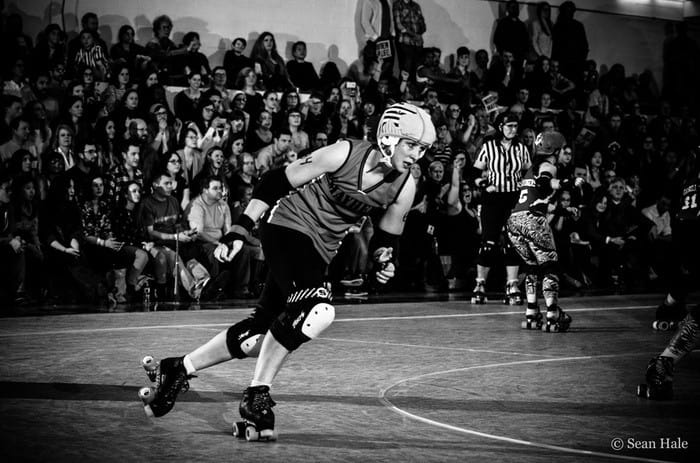The Cost to Create a Book: Derby Life

Margot Atwell shares how she budgeted to publish her Kickstarter-funded ode to roller derby.

In 2014, I had been running my roller derby website, Derbylife.com, for three years when I started to realize I couldn’t do it forever. After a lot of agonizing, I decided to focus on writing the book I wished I’d had when I got into the sport eight years years earlier. I wanted to write about the fascinating history of the sport, how to start playing, and how to deal with tough stuff like balancing roller derby with the rest of your life and dealing with the injuries that are inevitable in such an intense full-contact sport.
I wasn’t sure if fellow roller derby players and fans would want a print book about the sport, so I turned to Kickstarter, where I had been working as the Publishing Specialist for a few months, to test my theory and raise funds to make the book. I was concerned that my funding goal would seem way too high, or that there just wouldn’t be much of an audience for a print book about a niche sport (or at least enough of an audience to pay for the editing, preproduction, and printing costs). Fortunately, it worked — my Kickstarter goal was $7,000, and I raised $9,183 from 254 amazing backers. I got to make my book exactly the way I wanted to.
On the fourth anniversary of the publication of Derby Life, I wanted to share the real costs behind the project with others who are thinking about self-publishing a book. I’ll also share the decisions I made along the way and how I feel about those decisions in retrospect.

My costs
Content and preproduction: $4,994
When I launched the Kickstarter project, I was around 70 percent finished writing the manuscript (or so I thought), with one research-intensive history chapter remaining.
The preproduction and content costs came in quite high compared to what I had budgeted, especially the typesetting cost. The book ultimately ended up being around 80,000 words, plus 15 pages of images and several appendices. When I finally finished the manuscript, I had 320 pages rather than the 276 I had planned on.
This increased the cost of copyediting, proofreading, and typesetting pretty substantially. I was able to cut a few areas I had budgeted for, including paying someone to write a foreword, paying beta readers, and paying for the cover. I didn’t end up including a foreword, and my beta readers were extremely generous Kickstarter backers who backed at a level to get involved in the process. I worked with a friend and traded my editorial skills for his design skills for the cover and the Gutpunch Press logo, so I didn’t have to spend any money out of pocket for those elements.
I had budgeted $2,795 at the top of my budget; it ended up costing $3,279. Typesetting cost a lot more than I had budgeted for.

Printing: $4,336 (1,220 paperback copies)
Manufacturer: Edwards Brothers Malloy (now defunct)
There are several ways to print a book, and I got numerous estimates before making my choices. The highest-quality option I investigated was offset printing, which typically requires a minimum run of 750–1,000 copies but offers significant cost savings when printing more than that number.
Once I added the photos to the book, it was especially important for me to use a high-quality printer. I was hoping to be able to use offset printing, especially since I really liked the quality of Edwards Brothers Malloy, a printer I had favored in my previous life as a publisher. They offered me a 10 percent discount because of our previous relationship, which sealed the deal. I decided on a print run of 1,200 — a number high enough that I would have plenty of copies to sell post-campaign, but low enough that I was banking on not having hundreds or thousands of unsold copies left over to gather dust.
I coordinated carefully with the printer, but one challenge I hadn’t really expected was the delivery. It was most economical to have the books delivered by truck on a pallet. I had to ensure that the truck had a lift gate, since I didn’t have access to a warehouse with a loading dock. My extremely generous parents offered to let me have the books delivered to their garage in the suburbs of New York City rather than having over 1,000 pounds of books delivered to my third-story walkup in Brooklyn.
On the day of the delivery, I got a panicked call from my father about how the driver was trying to back an 18-wheeler up my parents’ extremely windy driveway. I thought for a moment that they would have to drop the pallet at the end of the driveway and we’d have to get the books to the garage from there, but somehow the miracle worker of a driver managed to back the truck up the driveway. My father sent this picture as evidence:


Kickstarter rewards fulfillment: $1,719
I sent 216 print copies of Derby Life to backers and saved another 80 or so for contributors and the people featured in the book. Shipping costs were a bit higher than I had budgeted for ($1,112 total, rather than $850) since I had more backers than I expected, including more international backers. I bought a laser printer for printing notes, labels, and more, which cost $248 but saved me infinite headaches (and probably also some money) in the long run. I also spent $120 on Shipstation software, which let me upload the backer information, buy postage, and print labels at home.
I was careful not to offer extraneous items (like T-shirts or tote bags) as rewards that would be costly or annoying to produce and ship. I had a leftover bag of Derbylife.com bottle-opener keychains that we had produced to promote the website, which I offered as part of a higher-level reward tier. I also offered postcards, which were very inexpensive and easy to fulfill, and e-books, which the typesetter produced for me inexpensively.
There were a few higher-tier rewards: one opportunistic one was a copy of a book by Damon Runyan (who helped create the full-contact version of roller derby) which I had discovered at a used bookstore in the Bay Area. I also offered a set of Derby Cards, custom sports memorabilia I had been dabbling in before starting this project.
The cost to fulfill the rewards overran my predictions by around 40 percent, which makes sense because I added the purchase of a printer and had to fulfill more rewards than I had initially budgeted for.
The final breakdown



The full cost of the project, including preproduction, content, printing, and rewards fulfillment, was $11,048.55.
Post-Kickstarter sales
I received $8,200 from the Kickstarter project, so the week before publication I was almost $3,000 in the red. This was a calculated choice. If I had printed just the copies I needed to fulfill the project (about 300) with a print-on-demand printer, it would have cost me $1,530, bringing my project’s total costs to $8,123, for a profit of $77. But I wanted to reach beyond my Kickstarter backers and sell copies of the book far and wide, so I invested the extra money to print an additional 900 copies to sell.
After I fulfilled the Kickstarter project, I had a few primary sales channels:
—Direct sales at roller derby events ($4,038.65)
—Sales via skate shops and a museum with a roller derby exhibit ($2,149)
—Online sales through my website, Amazon, and more ($8,253)
These sales were made at a range of rates, from full cover price ($15.95) to 50 percent off the cover price for stores to a deep discount when a friend asked to buy copies as rewards for her own roller derby–related Kickstarter project.
These additional sales came with additional costs, primarily shipping, marketing, and travel. I spent an additional $4,407.68 on these costs (which includes some of the travel I had originally done for research for the book, which I had expected to pay for out of pocket). This brought all the costs related to the project to $15,456.23. When you add up total sales ($14,440.65) and the Kickstarter funds ($8,200) and subtract the total costs ($15,456.23), my total before-tax profit on the book to date is $7,184.42.
A really conservative estimate of the amount of time I spent on the book and the project is 500 hours. This makes my rate of pay for the project $14.37 per hour. From an economic standpoint, I would have done better if I had taken a couple of freelance editing gigs. But I have definitely been paid worse on most of my other previous writing projects, so I’m not complaining!

In conclusion
Ultimately, my goal was to create a book that could act as a resource and companion for the next generation of roller derby skaters, and I definitely accomplished this.
From the start, I wish I had been more clear and firm about the length of the book. Overrunning my final estimate by 50 pages meant that my printing costs were $0.50 higher per copy, not to mention that the longer books are heavier and more expensive to ship. This has been especially challenging since I swapped to print-on-demand after my initial print run ran out because the POD costs are higher per unit. I ended up increasing the book’s price by a dollar to account for these higher costs, but it would have been better to invest a bit more time and money up front to fix this issue rather than have a book that’s quite expensive to continue producing and selling over time.
Ultimately, my goal was to create a book that could act as a resource and companion for the next generation of roller derby skaters, and I definitely accomplished this.
I’ve heard from readers from Brooklyn to Las Vegas, from Canada to Australia to the UK, and even from China who have read and appreciated the book. And just last month, I was quoted as an expert on the history of roller derby in The New York Times.
It truly would not have been possible to make this book without the jump-start my Kickstarter backers gave me.
To get your own copy of Derby Life, visit the Gutpunch Press website.
For more of Margot’s insights on money and publishing, follow her on Twitter or subscribe to her newsletter, On the Books, which talks about the intersection of money and publishing. To find out about new Publishing projects on Kickstarter, subscribe to Kickstarter Reads.
